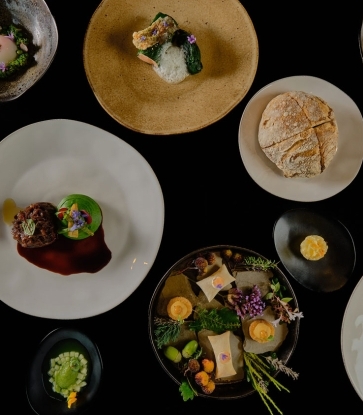One of the best ways to elevate a simple dish into something truly special is to introduce some alcohol when cooking. It may be used as an ingredient or primarily for the visual display (think: pouring rum over the sautéing bananas to elicit a flame when making bananas Foster). For example, wine is often used because of its acidic properties, fruity accent and bitter tannins.
There are countless ways to use alcohol, from bright marinades and sauces to hearty stews and chili, or from savory braised meats like beef Bourguignon to light and flavorful seafood dishes like steamed mussels. You'll frequently see alcohol used in desserts as well, such as in classics like crêpes Suzette.
When cooking with alcohol, there are a few key things to keep in mind. We spoke with chef Gabriel Kreuther behind his eponymous two-MICHELIN-starred restaurant about how he uses alcohol—especially wine—in cooking.
Know Your Goal
Consider whether the alcohol is being added to provide flavor or texture, or if it's more for visual appeal. Think about how you want the finished product to taste, look and feel."Usually you bring it to a boil and move the pot a little and burn the alcohol off," Kreuther explains. "What you're interested in when you're using wine is really the liquid. When you flame the alcohol out, you really enhance the body of the wine." That wine reduction you end up with is what is truly adding to the dish.
"You want to use a deep red, something that has a backbone. A lighter red with no body won't add much. With white wine, what you're looking for is the flavor, the aromatics, so that when you get the reduction you know there's something in it. In a cream sauce, wine is a way of getting a little acid in to add a sense of lightness and make the food more flavorful."
Alcohols with a higher proof and stronger flavor can also add a lot. "When you make something like foie gras," he explains, "you use alcohol for the terrine and then you go into cognacs, white Port and usually a little sweet wine like a Sauternes to provide a really interesting taste, flavor and succulence. Then spices come in. You play with the harmony of the alcohol and the spices. It elevates the dish."
While he says that technically any type of alcohol may be used, you want to be mindful of what you're ultimately going for and consider what the alcohol will add. "I think any alcohol can be used except you don't want to use the alcohols that are above 90 proof. You don't want to destroy the dish. You want to enhance and bring something to it and highlight it. Get it to a different dimension."
Go for Quality, but It Doesn't Have to Be Top-Shelf
"Exceptional products should be respected," Kreuther says. "Go with the generic wines produced to cook with—not one that gives you a headache, but something decent. The exquisite wine is better in your glass."Take source location into consideration as well. "When you're cooking in a specific region, you're using the wines of that region's terroir to highlight the food and give more substance and flavor to the food. It really gives a different character. You're creating so many layers. It can be as exciting as using spices. It's a very good complement when you use spices sparingly and you really know how to use alcohol or wines to add flavor. You're getting something that's completely different."
"In a big city," he adds, "it's different because you're in a cosmopolitan place, but in a place like California or the wine regions of France, you want to use what's around you and highlight the products of that region. That's the heart of terroir cooking."
Be Aware of Burn-Off Rates
How much alcohol burns off depends on the type of alcohol, the proof, the amount used and the cooking method and cooking time. In order for alcohol to evaporate, it must be exposed to air, and heat speeds up that process.While some alcohol is cooked off during cooking, the finished dish will typically still have some alcohol present, so you definitely need to take this into account. Alcohol simmered or baked in a dish for 15 minutes retains about 40 percent of its alcohol content. That amount goes down to 25 percent after an hour. You would need to cook a dish for about 2 hours 30 minutes to get to around only 5% remaining.





















